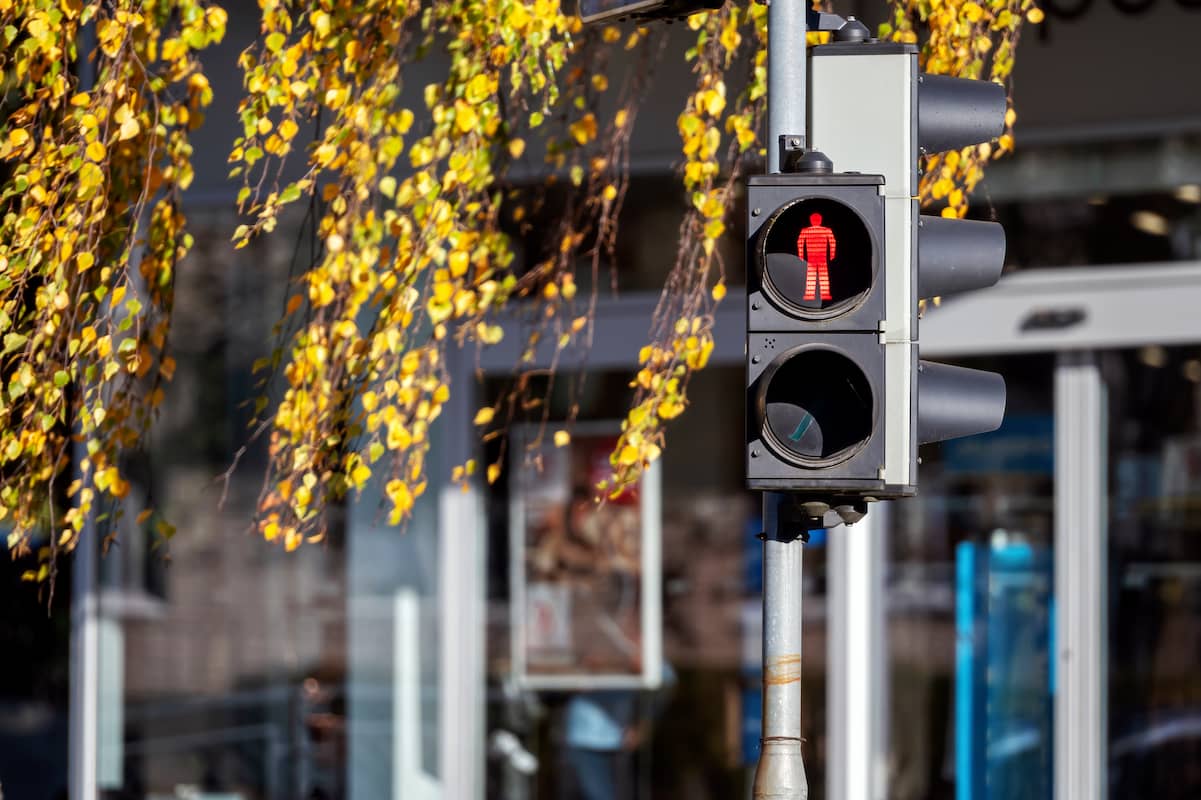What Are Pelican Crossings?
Pelican crossings are a type of pedestrian crossing used across the UK. The name stands for PEdestrian LIght CONtrolled crossing. They’re an older type of signal-controlled crossing that let pedestrians cross the road safely after pressing a button.
While puffin crossings are becoming more common, pelican crossings are still out there—especially in places that haven’t yet upgraded to newer systems. If you’re learning to drive in South Devon, chances are you’ll come across one, so it’s worth knowing how they work.
How Pelican Crossings Work
Pelican crossings have a simple button-and-lights setup. Here’s how it works:
- A pedestrian presses the button to request a crossing.
- Traffic lights change to red after a short wait.
- The pedestrian sees a green man across the road, signalling it’s safe to cross.
- After a fixed time, the green man starts flashing, warning pedestrians not to start crossing.
- At the same time, drivers see a flashing amber light, meaning they can move off only if the crossing is clear.
The key thing to remember is that pelican crossings don’t have sensors—they follow a fixed timing once activated.
Pelican vs Puffin Crossings: What’s the Difference?
It’s easy to confuse them, especially since both involve traffic lights and pedestrian buttons. But there are a few important differences:
| Feature | Pelican Crossing | Puffin Crossing |
|---|---|---|
| Pedestrian Signal | Opposite side of the road | Same side (nearside) |
| Flashing Amber Light for Drivers | Yes | No |
| Flashing Green Man for Pedestrians | Yes | No |
| Sensors | No | Yes – detects if someone is crossing |
| Timing | Fixed | Adjusts based on activity |
| Current Use | Being phased out | Preferred for new crossings |
Pelican crossings can be trickier because of the flashing light stage, especially for learner drivers.
Tips for Pedestrians at Pelican Crossings
- Only start crossing when you see the steady green man.
- Don’t begin crossing during the flashing green man—it means traffic may start moving.
- Press the button once and wait for the lights to change.
- Be aware that the lights follow a set timer—cars won’t stop indefinitely.
Tips for Drivers at Pelican Crossings
If you’re driving and approach a pelican crossing:
- Red light: Stop and wait.
- Flashing amber: You may move off only if no one is on the crossing.
- Always check the crossing is clear before moving during the flashing amber phase.
- Don’t try to beat the lights—respect the crossing sequence.
In your practical test, hesitation at a flashing amber or failing to check for pedestrians could lead to faults, so it’s worth practicing.
Where You’ll See Pelican Crossings in South Devon
While newer crossings are popping up in areas like Totnes, Newton Abbot, and Paignton, there are still pelican crossings in:
- Older town centres
- Near public buildings or schools
- Residential neighbourhoods
When learning with First Drive South West, we make sure you get familiar with both old and new types of pedestrian crossings—because understanding both helps you drive safely and confidently.
Are Pelican Crossings Being Replaced?
Yes—over time, pelican crossings are being replaced by puffin or even toucan crossings, especially in urban areas. These newer designs are more efficient and safer, thanks to their sensors and better signal placements.
That said, the UK still has thousands of pelican crossings in operation, so learner drivers need to understand them.
Why Knowing This Matters for Your Test
Whether it’s theory or practical, knowing how pelican crossings work is essential.
On the theory test, you’ll be asked about the meaning of flashing lights, pedestrian signals, and your responsibilities as a driver.
During your practical test, you could encounter a pelican crossing—so knowing when to stop, wait, and move safely can make the difference between a pass and a fault.
At First Drive South West, we go over all of this during your lessons, using real-life examples around South Devon so you’re ready for anything.
Quick Recap: What Are Pelican Crossings?
They’re button-controlled pedestrian crossings with fixed timing and a flashing amber phase for drivers. While they’re gradually being replaced, they’re still common across the UK—and it’s important for learner drivers to understand how to approach them safely.
Drive Confidently with First Drive South West
If you’re learning to drive in South Devon, we’ll help you master every type of crossing—from classic pelicans to modern puffins. Our friendly instructors make sure you’re fully prepared, whether it’s your first lesson or your test is just around the corner.
Book your driving lessons today with First Drive South West and learn from local experts who know the roads—and how to help you pass first time.
